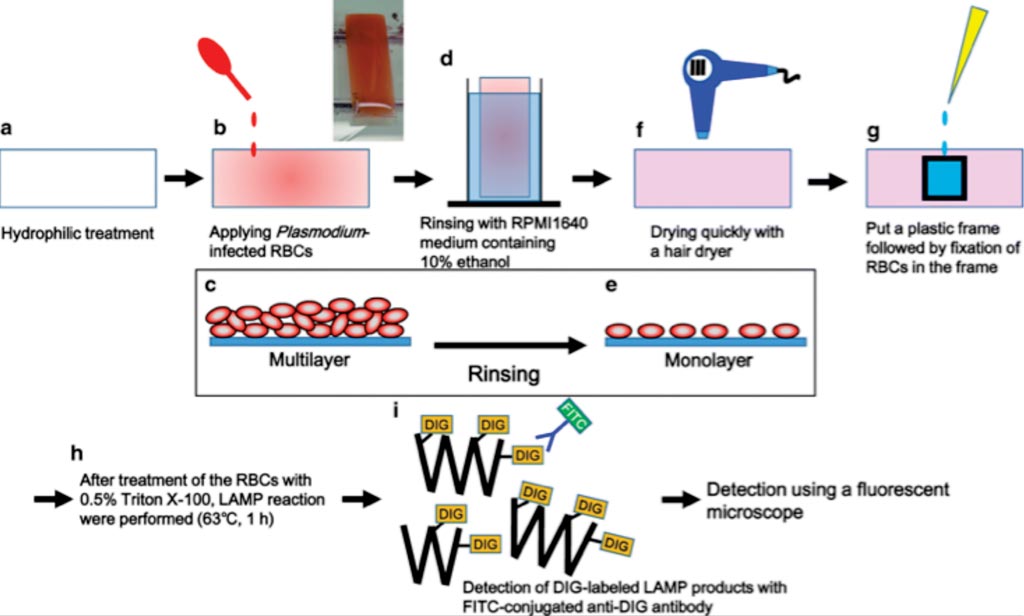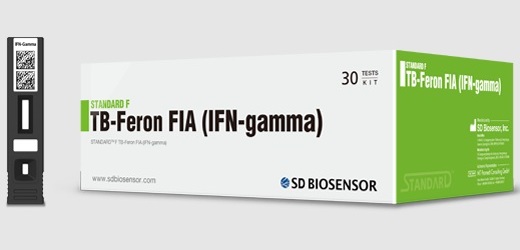Loop-Mediated Isothermal Amplification Identifies Malaria Species
By LabMedica International staff writers
Posted on 05 Jul 2018
Malaria is an infectious disease caused by different species of Plasmodium, of which, five species are reported to infect humans. Since malaria caused by P. falciparum is the most serious, with high mortality, accurate and prompt diagnosis is especially important to effective management.Posted on 05 Jul 2018
The current gold standard for malaria diagnosis is microscopic examination of Giemsa-stained blood smears. Since the parasite species are identified by microscopists who manually search for the parasite-infected red blood cells (RBCs), misdiagnosis due to human error tends to occur in case of low parasitaemia or mixed infection.

Image: A diagram of the protocol for in situ LAMP for Plasmodium-infected red blood cells on hydrophilic-treated cyclic olefin copolymer (COC) plates (Photo courtesy of National Institute of Advanced Industrial Science and Technology).
Scientists at the National Institute of Advanced Industrial Science and Technology (Takamatsu, Japan) performed in situ Loop-Mediated Isothermal Amplification (LAMP) in infected red blood cells (iRBCs) on hydrophilic-treated plates to analyze as many iRBCs as possible on a slide. The identification of malarial parasite at cellular levels using in situ LAMP assay was able to be completed. The team used fresh RBCs from a healthy donor with blood type O were infected with P. falciparum, which contained more than 60% of ring-stage, more than 20% of late trophozoite-stage, and less than 20% of schizont-stage parasites.
Red blood cell suspensions, including cultured Plasmodium falciparum, strain 3D7, infected-RBCs, were dispersed on cyclic olefin copolymer (COC) plate surfaces rendered hydrophilic by reactive ion-etching treatment using a SAMCO RIE system (hydrophilic-treated), followed by standing for 10 minutes to allow the RBCs to settle down on the plate surface. By rinsing the plate with RPMI 1640 medium, monolayers of RBCs formed on almost the entire plate surface. The plate was then dried with a hair drier. The RBCs were fixed with formalin, followed by permeabilization with Triton X-100. Then, amplification of the P. falciparum 18S rRNA gene by the LAMP reaction with digoxigenin (DIG)-labeled dUTP and a specific primer set was performed. Infected RBCs as fluorescence-positive cells with anti-DIG antibodies conjugated with fluorescein using fluorescent microscopy could be detected.
The authors concluded that their study showed the potential of in situ LAMP for the identification of Plasmodium species at the single cell level on hydrophilic-treated COC palates, allowing highly sensitive and accurate malaria diagnosis. The findings will improve the efficacy of the gold standard method for malaria diagnosis. The study was published on June 19, 2018, in the Malaria Journal.
Related Links:
National Institute of Advanced Industrial Science and Technology








 (3) (1).png)





